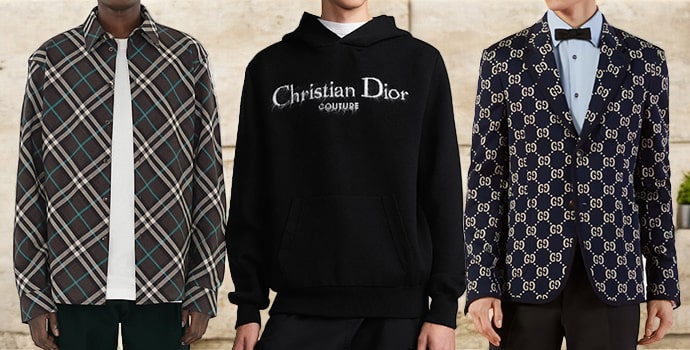Common Fabric Types Used in Branded Clothing and What They Mean
Common Fabric Types Used in Branded Clothing and What They Mean
Blog Article
The Importance of Lasting Apparel: Exactly How It Impacts the Atmosphere and Your Closet
Sustainable garments is progressively recognized for its critical function in minimizing the ecological influence of the rapid garment industry. By concentrating on green products and moral production methods, it attends to pushing eco-friendly worries. This shift not only benefits the planet however additionally influences customer choices, causing a more thoughtful technique to wardrobe monitoring. Comprehending these characteristics increases vital inquiries concerning style's future and individual duty fit it.
The Environmental Footprint of Rapid Fashion

Benefits of Sustainable Products
Lasting products offer significant benefits, particularly via environment-friendly fabric options that decrease environmental damage. These materials additionally demonstrate sturdiness and durability, decreasing the demand for regular substitutes. As an outcome, they contribute to a much more sustainable fashion business and promote liable customer behavior.
Eco-Friendly Fabric Options
While the fashion business has actually long been connected with rapid trends and ecological harm, the increase of green fabric choices offers a transformative possibility. Lasting products such as organic cotton, hemp, and Tencel have actually gotten appeal because of their reduced eco-friendly influence. These fabrics are often produced without hazardous chemicals and call for less water, decreasing their carbon impact - Branded Clothing. Additionally, several green materials are naturally degradable, contributing to a round economic situation by decreasing waste. Selecting lasting products not only supports ecologically liable techniques yet likewise promotes much healthier ecosystems. As consumers become a lot more knowledgeable about their acquiring power, the demand for environmentally friendly textiles encourages brands to introduce and adopt more lasting manufacturing approaches, ultimately profiting the earth and future generations
Resilience and Long Life Benefits
Several customers are progressively identifying the durability and longevity benefits of sustainable materials in their clothing choices. Unlike traditional materials, lasting materials such as natural cotton, hemp, and recycled polyester are engineered to withstand damage, causing garments that last much longer. This decreased regularity of substitute not only saves consumers money gradually however likewise reduces waste created by rapid fashion. Additionally, lasting garments commonly employs green production approaches that improve fabric toughness, contributing to a reduction in the total carbon footprint. By purchasing long lasting garments, consumers can grow an extra sustainable closet while enjoying high-grade pieces that maintain their visual and performance gradually. Subsequently, toughness and durability stand as vital advantages of choosing lasting products.
Reducing Waste Through Sustainable Practices
Lowering waste in the fashion business can be accomplished via ingenious methods such as upcycling and repurposing products. In addition, taking on minimal wardrobe approaches encourages consumers to focus on high quality over amount, eventually reducing clothing intake. With each other, these techniques add significantly to an extra lasting clothes model.
Upcycling and Repurposing Products
Upcycling and repurposing products have actually emerged as ingenious approaches in the apparel industry, changing disposed of fabrics into valuable brand-new products. This approach not only decreases waste but additionally urges imagination and uniqueness in apparel layout. By taking old garments and products, developers can develop one-of-a-kind pieces that mirror personal design while minimizing the demand for brand-new resources. Additionally, upcycling commonly calls for less energy and water compared to conventional manufacturing procedures, substantially lowering the ecological impact of style. As consumers become much more familiar with sustainability, the popularity of upcycled garments proceeds to climb, advertising a circular economy. Eventually, these practices add to a much more sustainable future, where fashion focuses on ecological health and wellness over fast production and intake.

Minimalist Closet Approaches
As individuals progressively look for to decrease their ecological influence, embracing minimalist wardrobe strategies has acquired grip as an effective strategy to sustainable style. These approaches stress quality over quantity, encouraging consumers to curate a smaller sized collection of functional, long lasting garments. By concentrating on timeless items that can be combined and matched, individuals can decrease the regularity of purchases and ultimately decrease waste.Additionally, minimalism advertises conscious usage, advising consumers to mirror on the ethical and environmental implications of their options. This technique not just promotes a much more sustainable way of life yet also simplifies day-to-day decision-making regarding attire. As individuals welcome minimalist concepts, they add to a style culture that values sustainability and responsible consumerism, ultimately bring about a much more eco-conscious society.
The Function of Ethical Labor in Lasting Style
While lots of consumers are increasingly familiar with the environmental effects of their clothing options, the significance of ethical labor methods in sustainable fashion can not be neglected. Honest labor encompasses fair salaries, secure working problems, and respect for employees' legal rights, creating the foundation of liable fashion manufacturing. Brands that focus on moral labor not only uplift communities but additionally established a standard for liability in the industry.Moreover, the combination of honest methods promotes transparency, allowing customers to make enlightened selections regarding their purchases. This practice contrasts sharply with rapid fashion's unscrupulous labor versions, which typically prioritize revenue over individuals. By sustaining companies dedicated to ethical labor, consumers add to a system that values human self-respect together with environmental sustainability. Subsequently, honest labor is not merely an add-on; it is necessary to the broader mission of sustainable style, ensuring that the quest for eco-friendliness does not come at the expense of human civil liberties.
The Effect of Sustainable Garments on Carbon Emissions
Lasting apparel has the prospective to substantially minimize carbon discharges related to the garment industry. Conventional garment manufacturing adds notably to greenhouse gas exhausts, largely due to energy-intensive manufacturing procedures and making use of non-renewable sources. On the other hand, lasting fashion concentrates on environment-friendly materials, such as organic cotton or recycled fibers, which commonly require much less power to produce.Moreover, lasting brand names tend to take on more efficient production techniques, minimizing waste and decreasing overall emissions. By prioritizing longevity and timeless design, lasting apparel urges customers to acquire less often, further lowering the carbon impact connected with overconsumption.Additionally, numerous lasting brands are devoted to transparency in their supply chains, enabling consumers to make informed choices that line up with their values. Ultimately, changing in the direction of sustainable garments can bring about a substantial decrease in carbon exhausts, contributing to a healthier earth and an extra sustainable future for the fashion business.
Supporting Local Economic Climates With Lasting Selections
The shift toward sustainable clothes not only addresses environmental concerns but additionally significantly advantages neighborhood economies. By picking sustainable fashion, consumers typically sustain tiny organizations and local craftsmens, boosting area strength. These business commonly operate a smaller range, focusing on craftsmanship and moral methods over mass production.Investing in locally made sustainable clothing fosters work production and stimulates financial growth within communities. As visit homepage customers end up being much more aware of the ecological influence of their purchases, they progressively seek items that mirror their values. This need motivates regional makers to embrace lasting techniques, contributing to a round economy.Moreover, supporting neighborhood companies reduces transportation emissions, aligning with eco-conscious consumer habits. The interconnectedness of sustainable apparel and local economic climates emphasizes the necessary duty that individual choices play in promoting both financial and ecological wellness. By cultivating these neighborhood links, areas can grow while additionally functioning in the direction of a more lasting future.
Transforming Your Storage Room: Tips for a Sustainable Wardrobe
As individuals look for to decrease their ecological effect, changing a closet into a sustainable closet ends up being an important step. One efficient approach is to review existing clothing, keeping just things that are used regularly and that line up with sustainability goals. Focusing on top quality over quantity is essential; spending in durable items from green brands can greatly reduce waste.Additionally, integrating pre-owned items can breathe brand-new life right into a wardrobe while lessening ecological damages. Organizing apparel swaps with good friends or contributing unused things can further advertise sustainability.When shopping, people ought to look for products that are natural, recycled, or eco-friendly, and prevent fast fashion merchants - Branded Clothing. Exercising conscious usage by attentively considering each acquisition can contribute to a much more sustainable way of life. By applying these pointers, one can produce a closet that reflects individual style while sustaining ecological stewardship
Frequently Asked Questions
Exactly How Can I Identify Lasting Apparel Brands?
To identify lasting garments brand names, one must look into products made use of, inspect for certifications like Fair Profession, and check out the brand's openness about their manufacturing procedures, labor methods, and ecological effect, ensuring environment-friendly and honest practices are prioritized.
What Are the Prices Connected With Lasting Fashion?
The costs linked with sustainable fashion can differ considerably. Greater manufacturing expenditures, moral sourcing, and environmentally friendly products frequently cause increased market prices, which may deter some consumers while appealing to ecologically mindful customers.
Can Lasting Apparel Be Trendy and fashionable?
Sustainable apparel can certainly be fashionable and trendy. Designers significantly focus on innovative products and honest manufacturing techniques, verifying that fashion and sustainability can exist side-by-side. Consumers currently have diverse choices that mix looks with environmental awareness.
Exactly How Does Washing Garments Affect Their Sustainability?
Cleaning clothing considerably effects sustainability by consuming Learn More water and power, adding to air pollution, and creating microplastic release. Regular cleaning can degrade textiles, reducing their life expectancy and enhancing the requirement for substitutes, eventually intensifying ecological problems.
What Is the Life Expectancy of Sustainable Garments Contrasted to Rapid Fashion?
The lifespan of sustainable garments typically goes beyond that of fast fashion things, often lasting several years due to top quality products and craftsmanship. On the other hand, fast style garments may weaken promptly, necessitating even more frequent substitutes. Sustainable clothes is significantly recognized for its essential role in minimizing the ecological influence of the rapid style sector. While numerous customers are progressively aware of the environmental consequences of their garments selections, the significance of moral labor practices in lasting style can not be ignored. Branded Clothing. Sustainable clothes has the click for info possible to significantly lower carbon discharges associated with the fashion market. In comparison, lasting fashion focuses on environment-friendly materials, such as natural cotton or recycled fibers, which often call for less energy to produce.Moreover, sustainable brands often tend to adopt more efficient manufacturing practices, minimizing waste and decreasing general discharges. By prioritizing durability and ageless design, lasting garments encourages consumers to buy less frequently, more minimizing the carbon footprint connected with overconsumption.Additionally, lots of sustainable brand names are dedicated to openness in their supply chains, enabling customers to make educated choices that align with their values
Report this page